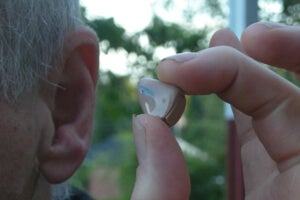Television, cellphones, radio, WiFi—modern civilization converses in radio waves.
Most of us need some kind of device to translate the signals into something we can consume on a screen or through a speaker. But in the television show, Alphas, one of the characters, Gary Bell, can literally see and read electromagnetic waves.
In the show, Bell’s ability is a fictional superpower—but the larger point? The world is brimming with information invisible to our fairly limited senses. A new project, Phantom Terrains aims to make us all a little bit more like Gary Bell.
 The project is a collaboration between Frank Swain and Daniel Jones. Swain, a writer, suffers from progressive hearing loss and recently got hearing aids. Jones is an artist and software engineer specializing in sound and technology. The two got together and hacked Swain’s hearing aids to not only augment his hearing, but give him another sense entirely.
The project is a collaboration between Frank Swain and Daniel Jones. Swain, a writer, suffers from progressive hearing loss and recently got hearing aids. Jones is an artist and software engineer specializing in sound and technology. The two got together and hacked Swain’s hearing aids to not only augment his hearing, but give him another sense entirely.
The hacked hearing aids pick up WiFi signals and translate network identifiers, data rates, and encryption modes into sounds. Combined, they make for a unique audio fingerprint that can be recognized, granting a sense of a city’s “invisible data topographies” as they walk the streets.
How does it work?
There’s a layer of clicks, a bit like a geiger counter or dolphin chatter, indicating network density. The more networks there are, the denser the clicking. As Swain approaches networks, they click faster. As he passes them, they click more slowly. If they’re on the right, they sound in the right ear, and if on the left, the left ear. Network IDs are translated to musical notes.
Most routers will start with the same notes—assigned to British Telecom customers—but after that, the largely novel combinations sing different tunes. The pair made a recording of a walk Swain took outside the BBC in London.
From the perspective of extrasensory powers—Phantom Terrains isn’t as novel as it seems. We tap into radio waves to listen to music or make cellphone calls. The information is similarly translated by the device. Sometimes we even use earbuds.
But Phantom Terrains is really about something else—devices can turn a disability into a superability. The artist, Neil Harbisson, for example, is color blind—so he wears an “electronic eye” that records colors and translates them into sound.
Or how about the Argus II bionic eye? The Argus system allows legally blind folks to see (and even read) in black and white. Argus might one day restore vision in the standard visible spectrum, and maybe beyond too, into the infrared, for example.
Robotic prosthetics and exoskeletons might not only restore mobility, but enhance it. Users may lift more, jump higher, run faster. And with RFID chip implants people could open doors, start cars, or access locked devices with a hand wave.
Humans merging with machines seems extreme. But it’s already happening, and for those with a disability, there’s nothing controversial about it at all. Perhaps when these folks gain superabilities—others might decide they’d like the same thing.
From a more purely artistic view, I like the project because it’s a visceral illustration of this invisible field of information all around us. I hesitate to call it magical because of all the baggage that entails—but it is a little bit magical, isn’t it?
Image Credit: Phantom Terrains



